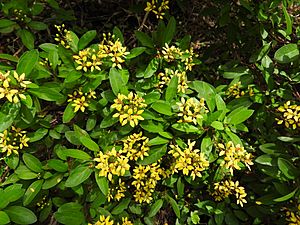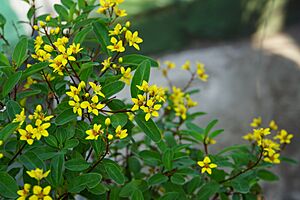Rain of gold facts for kids
Galphimia glauca, also known as rain of gold or golden showers, is a beautiful flowering shrub. It belongs to the Malpighiaceae family and grows naturally in Central America. People love this plant for its bright yellow flowers that look like a shower of gold!
Quick facts for kids Rain of gold |
|
|---|---|
 |
|
| Scientific classification | |
| Genus: |
Galphimia
|
| Species: |
glauca
|
Contents
What Does the Rain of Gold Plant Look Like?
This plant is an evergreen shrub, meaning it keeps its leaves all year round. It grows straight up and can reach a height of about 1.8 to 3 meters (6 to 10 feet). It has a strong taproot system, which is like a main root that grows deep into the ground.
The leaves grow one after another along the stem. They are oval-shaped and green on top, with a bluish-green color underneath. Sometimes, they can turn a bronze color when it gets cold.
Flowers of the Golden Showers
The flowers smell sweet and are bright yellow. Each flower is about 2 centimeters (0.8 inches) wide and has 5 petals and 5 sepals (small leaf-like parts that protect the flower bud). These flowers grow in clusters called racemes, which are like long stalks with many flowers.
This plant can bloom almost all year if it has enough sunlight and the right conditions. However, it usually blooms mostly from early spring until the first frost of winter.
Galphimia glauca is similar to another plant called Galphimia gracilis. You can tell them apart by their flowers. In G. gracilis, the petals fall off when the fruit starts to grow. But in G. glauca, the petals stay on even when the fruit is forming.
Where Does the Rain of Gold Plant Grow?
This plant is native to Mexico, Guatemala, and Panama. It grows in places with warm or mild weather, usually between 920 and 2600 meters (about 3,000 to 8,500 feet) above the sea.
You can find it in fields where the natural plants have been changed, like in tropical forests (both those that lose their leaves and those that don't), dry scrublands, and forests with oak, pine, or juniper trees. This plant is quite tough! It can grow in drier areas and can even survive light frosts down to about -2 degrees Celsius (28 degrees Fahrenheit).
Traditional Uses of the Rain of Gold Plant
The fruits of this plant are full of vitamin C, which is good for you. In traditional Mexican folk medicine (old ways of healing), people make a tea from the plant's leaves. This tea is used to help with things like chest pain, to calm down anxiety (feeling worried), and to treat problems like diarrhea, asthma, malaria, and stomach issues.
The plant also has special compounds that can act like an antihistamine (to help with allergies like hayfever), an anticonvulsant (to help with seizures), an anti-allergic medicine, and a sedative (to help you relax). This is because it contains helpful substances like quercetin, phenolics, triterpenoids, and flavonoids.
Gallery
See also
 In Spanish: Galphimia glauca para niños
In Spanish: Galphimia glauca para niños
- Tristellateia australasiae, a vine in the same family also called "shower of gold"







